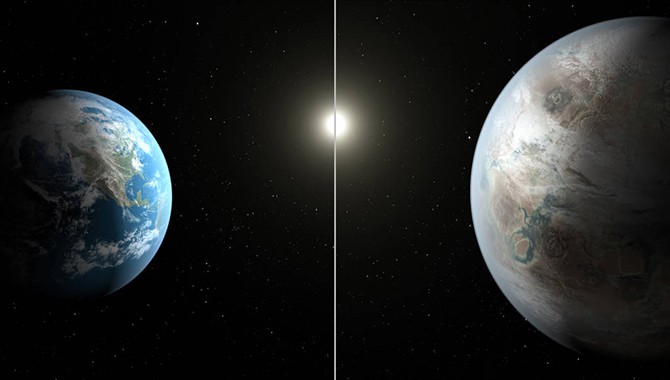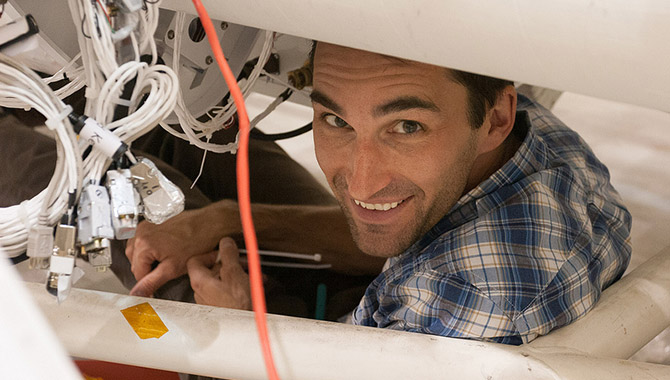
In this artist’s concept, Earth (left) is contrasted with Kepler-452b (right) and their respective G2-type stars.
Image Credit: NASA/Ames/JPL-Caltech/T. Pyle
Faced with potentially mission-ending challenges, the Kepler team altered its approach and is now more efficient than ever at identifying Earth-like exoplanets.
Launched in 2009, the Kepler mission was tasked with finding Earth-like worlds orbiting sun-like stars beyond our solar system. Reaction wheel failures in 2012 and 2013 threatened the mission’s future by crippling its ability to collect relevant data. But new software is allowing the team to analyze the existing data efficiently and uniformly, leading to the discovery of more “candidates”: exoplanets that are similar to Earth.
“We’re no longer finding new candidates due to collecting more data; we’re finding them due to an improvement in our techniques. We’re understanding the Kepler data better with every single day and we’re improving our ways to find the planets in those data,” said Jeff Coughlin, Kepler research scientist at SETI Institute in Mountain View, CA.
There are two steps to the planet-finding process. The Kepler team mastered the first during its initial mission: identifying periodic dips in the brightness of a star that could be caused by a planet moving in front of it. The challenge was in confirming that this dip in brightness was actually caused by the transit of a planet and not a random fluctuation in the star’s light. To overcome this challenge and confirm the existence of an exoplanet, at least three observations are required.
After confirming a potential candidate, “the second step of the planet-finding process is to really dig in deep to the data and assess these transit-like signals—or, as we call them, Kepler Objects of Interest, KOIs,” said Coughlin. “The first part has been fully automated since the start of the mission. However, that second step—really digging into the data—has traditionally been handled by a team of scientists that looked at a series of plots and diagnostics.” Despite a team made up of the best in the business, this step was extremely time consuming, limiting their ability to analyze the extensive data that Kepler has collected over the years.
Recently this changed. “[W]hat we did was to automate this second step. We basically wrote some robotic software that captures the human decision-making process that this team was employing, and I think we did so quite successfully. As a result, we’re now able to assess all the transit-like signals with the entire Kepler dataset in a very uniform fashion.”
The result? The Kepler team just uncovered the most Earth-like exoplanet to date. The new technique enabled them to pinpoint Kepler-452b: “The first small planet in the habitable zone of a G-type star very similar to our own sun,” said Jon Jenkins, Kepler data analysis lead at Ames Research Center (ARC).
Unlike previously discovered exoplanets, Kepler-452b orbits a G2 star, which is the same kind of star as Earth’s sun. Potential Earth-like planets discovered by Kepler in the past orbited other types, such as K stars or M stars. “[This] star is the same surface temperature and type as the sun,” said Jenkins, although—because it is older—it is 10% larger and 20% brighter.
The relationship between this G2 star and its planet is comparable to that of Earth and its sun. The planets’ orbits are similar in duration: 385 days for Kepler-452b compared with 365 days for Earth. The radius of the exoplanet is 50% larger and it has a greater-than-even chance of being rocky, like Earth. It is 5% farther from its star than Earth is from the sun, but since its star is somewhat larger and brighter, Kepler-452b is in the habitable zone: the distance from its star that implies liquid water could exist on its surface.
“It’s simply awe inspiring to consider that this planet has spent six billion years in the habitable zone of its star, which is longer than the age of the earth. That’s considerable time and opportunity for life to arise somewhere on its surface or in its oceans should all the necessary ingredients and conditions for life exist on this planet,” said Jenkins.
So far, this and other findings from the Kepler mission have fueled the likelihood that there is a planet beyond our solar system that mirrors Earth and could sustain life. John Grunsfeld, associate administrator for the Science Mission Directorate (SMD), said we now know that, “most of the stars that you see in the night sky have solar systems around them. And while that’s extremely exciting and satisfying to know, there’s still the question: are there suns like our own with planets like our Earth around them?”
Thanks to Kepler, the answer increasingly appears to be yes. According to Jenkins, “We can say that near Earth-size planets in the habitable zone of sun-like stars are common throughout the galaxy.”
“Planets like Jupiter that are really huge are rare. The most common type of planets are small, rocky planets like the earth,” confirmed Coughlin. “This is really exciting.”
The Kepler mission recently released its seventh catalog. This edition incorporates all of the data collected by the spacecraft during its original mission and, by utilizing the new data analysis technique, adds 500 new candidate planets. The catalog is available to scientists and the public, offering everyone the opportunity to dig deep into the data and continue the search for Earth-like exoplanets for decades to come.
Kepler mission development was managed by the Jet Propulsion Laboratory (JPL). The original and current missions are run by ARC for the SMD. The spacecraft’s flight system is operated by Ball Aerospace & Technologies Corporation in conjunction with the Laboratory for Atmospheric and Space Physics at the University of Colorado in Boulder.
Visit the NASA Exoplanet Archive and access the Kepler Planetary Catalog.
View an animated illustration of the possible appearance of Kepler-452b and learn more about the exo-planet.









